The aquatic world is filled with boundless species that enthrall the human mind. One of such is the angelfish, which is a type of ray-finned fish.
With so many species attributed to the saltwater angelfish, they can be classified into two groups. There are the Marine and Freshwater angelfish, which all have unique body-color patterns.
Thanks to their unusual shape and beautiful body colors, both freshwater and marine angelfish are very popular fishes for reef tanks, but not all angelfish are reef safe fish.
This is because they tend to pick on noxious soft corals, especially in the absence of live rock, causing the corals to die.
However, below are the 13 best reef safe angelfish for your saltwater reef tank.
Interesting Facts About Angelfish:
Most popular dwarf angelfish can reach 2 to 24 inches in length, depending on the species. They are mostly omnivorous, and they eat algae and even corals. This one-of-a-kind fish is a brilliant creature that can recognize its owners.
This is due to their optic lobes, and it has even been proven that some saltwater angelfish species can recognize their reef tank mates. It is also challenging to differentiate between males and females because they are equal in size and have the same color.
Reef Safe Angelfish – Dwarf Species
Even as adults, the Dwarf Angelfish species seldom grows greater than 5 inches in length.
1. Pearlback Angelfish
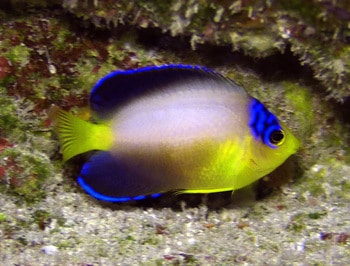
This striking angelfish is of those fish considered semi-aggressive, especially in a small tank where it is challenged. This angel fish needs a lot of hiding places and live rock for grazing on microalgae. They may nip at clam mantles and stony and soft corals.
Specie Overview:
- Length: About 4 inches
- Tank size: 280L (70gal)
- Other names: Multicolor Angelfish
- Physical features: They have pale peach-orange to Yellow; black speckles on a blue background behind the eye; blue-black dorsal and anal fin while the caudal fin is yellow; horizontal swatch of silvery-white from the mid-body to the caudal fin.
2. Fisher’s Angelfish
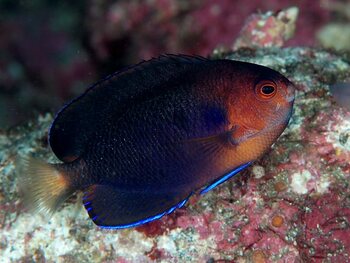
The fisher’s angelfish is a dwarf salt-water angel fish. Like most angels, this fish will nip at stony and soft corals, sessile inverts, and clams but with caution. Fisher’s angelfish is usually the only dwarf angelfish in the tank to avoid aggression and territorial issues.
To ensure fisher’s angelfish thrives, your reef aquarium should be decorated with many hiding places and live rocks to promote algae growth. This will allow them to feed on the algae instead of your corals. It should also be noted that it is hard to differentiate between males and females, so it is hard to breed them in captivity.
- Specie Overview:
- Length: About 4 inches
- Tank size: 113L (30gal)
- Other names: Fisheri Angel
- Physical features: It has an orange body and thin sapphire blue outline highlighting the body and anal fin.
3. Potter’s Angelfish

The Potter’s Angelfish, like other Entropyge angels, is an egg-laying synchronous protogynous hermaphrodite. It should be noted that this fish has a better survival rate in a reef aquarium.
This fish is a Hawaiian endemic and is not 100% reef safe as it may pick at corals and other invertebrates, including clams and worms.
If kept in a reef tank with plenty of algae for it to graze on, this angelfish should leave most corals alone. This fish must be kept with calm and non-aggressive mates in your reef aquarium, as they can be quite shy.
Specie Overview:
- Length: About 5 inches
- Tank size: 280L (70gal)
- Other names: Russet angelfish
- Physical features: They feature bright rusty orange overall with blue lines over the body and fin. The orange darkens to blue/black on the lower side, with the dark area usually more pronounced in males. They also have blue fins.
4. Cherub Angelfish
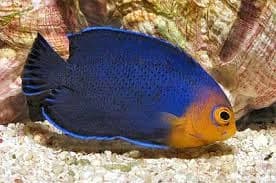
The cherub angelfish belongs to the pygmy angelfish family and thrives in the Western Atlantic. They are often found in shallow waters and are commonly referred to as reef-safe with caution.
They’re not known to be specifically irritating to corals or clams. Keeping the Cherub angelfish alone in a reef tank is usually advisable because they can be aggressive to other fishes.
However, they can be kept in pairs if reef tanks are larger than 75 gallons, or they should be the last fish added to the aquarium. Although there are not 100% reef safe, they are among the safest choices for a dwarf angel and sessile invertebrates.
Specie Overview:
- Length: About 4 inches
- Tank size: 285L (75gal)
- Other names: Yellow face Pygmy
- Physical features: They have a metallic blue body and Yellow to orange parts on the head only.
5. Coral Beauty Angelfish

The Coral Beauty is a magnificent coral reef safe angelfish commonly collected and surprisingly very easy to care for.
It is among the most popular of the dwarf angelfish and is also widely referred to as dusky angelfish. This fish thrives in the Indo-Pacific Ocean and mostly dwells in reefs or lagoons.
Coral beauty angelfish prefer tanks with live rock and enough spaces to hide as it is quite shy in many cases.
In addition to its physical appearance, this coral beauty fish can also help keep nuisance in check. Though generally non-aggressive, this fish may display territorial aggression in tanks of insufficient size.
Specie Overview:
- Length: About 4 inches
- Tank size: 113L (30gal)
- Other names: Two spined angelfish
- Physical features: They have dark blue color along the outline of their body, orange in the center, and yellow on their pectoral fins.
Cultivating and maintaining a reef tank is not an easy task. Although it comes with lots of challenges, you will do just fine with proper knowledge of what kind of fish is completely reef safe for your reef tank and their feeding modes.
It is important you note that consistently feeding your angelfish will reduce the chances of them targeting and feeding off your corals and clams.
Reef Safe Angelfish – Large Species
There are several large angelfish on the list that include the warning: reef safe with caution. They may be fine and leave your corals alone, but they might not.
Before adding them to your fish tank with corals, make sure they’ve been properly acclimated to aquarium-prepared foods in quarantine. Keep an eye on the tank and address any issues as soon as possible.
6. Masked Angelfish
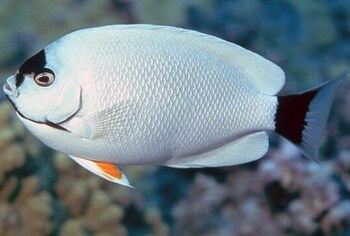
This marine species is found around Hawaiian islands and is majorly associated with coral reefs. The masked angelfish’s grace and beauty instantly make it a show-stopper in any reef aquarium it is found in. Although this fish is expensive, its beauty makes it worth any price.
The best part about this fish is that it is reef-safe and easy to care for.
Specie Overviews:
- Length: About 9 inches
- Tank size: 570L (150gal)
- Other names: Personatus
- Physical features: Females are black and white while mature males turn from black to Yellow and orange fins.
7. Lemonpeel Angelfish

The Lemonpeel angelfish are known for nibbling large-polyp, stony corals, and clam mantel. This kind of fish dwells in solitary and prefers to stay closer to caves or shelters. They can only be kept with other angelfish if the tank is large as they are aggressive to other angelfish.
Specie Overview:
- Length: About 6.5 inches
- Tank size: 285L (75gal)
- Other names: Blue zoo
- Physical features: They have a uniform bright yellow body with a blue ring around the eye and dark blue edges on the vertical fin.
8. Swallowtail Angelfish

The swallowtail angelfish is one of the members of the Genicanthus semifasciatus and is also referred to as the masked swallow angelfish. They are planktivores and are reef safe. This kind of fish is peaceful and usually poses no threats to other fish or invertebrates.
This beautiful Japanese Swallowtail angelfish is a mid-water column fish, which means it doesn’t live on the reef or close to the surface. This fish needs a large tank and spacious swimming area to thrive properly.
Specie Overview:
- Length: About 7 inches
- Tank size: 285L (75gal)
- Other names: Zebra angelfish
- Physical features: Female has a Yellow strip on the back, a light blue body, and black and blue stripes at the tail. The male has an additional thick black line on the body.
9. Flame Angelfish

Flame angel fish, which is one of the famous dwarf angelfish, is exceptionally beautiful. This fish can quickly adapt to a captive diet, which usually prevents them from consuming stony and strong corals.
The flame angel is considered semi-aggressive by most and may display some territoriality towards any fish added to the reef tank aquarium after they must have established their territory.
Specie Overview:
- Length: About 6 inches
- Tank size: 280L (70gal)
- Other names: Dwarf Flames.
- Physical features: They boast of bold red/orange color, vertical black stripes highlighting the body, horizontal black stripes along the caudal portions, and blue-tipped dorsal and anal fin.
10. Orangelined Or Eibl’s Angelfish
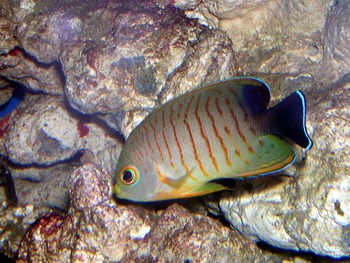
The Orangelined angelfish is found near reefs in the Indo-pacific. With a tendency to be docile, the orange-lined angelfish can become quite controlling once established.
Although this angel fish is not aggressive, they occasionally nib on corals and clam mantles. But, if you feed them properly, there is a greater chance of them leaving your corals alone.
For the most part, the orange-lined angel fish is reef safe, and they prefer not to be bred with other dwarf angels.
Specie Overview:
- Length: About 6 inches
- Tank size: 285L (70gal)
- Other names: Eibl’s
- Physical features: It features a pearlescent body highlighted with several vertical, evenly spread orange stripes. The back of the body and fin are black, and a blue stripe outlines the fin.
11. Emperor Angelfish
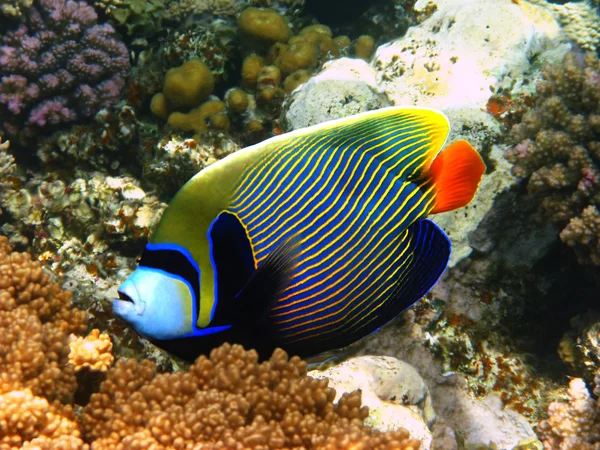
The Emperor Angelfish reaches a full length of 15 inches and requires a tank volume of 220 gallons due to its enormous size.
This fish is a peaceful creature that spends its time swimming in the water column and grazing on algae. The Emperor Angelfish is a beautiful fish with a blue body and yellow stripes. This fish is a popular choice for saltwater aquariums because of its vibrant colors and peaceful nature.
12. Scribbled Angelfish
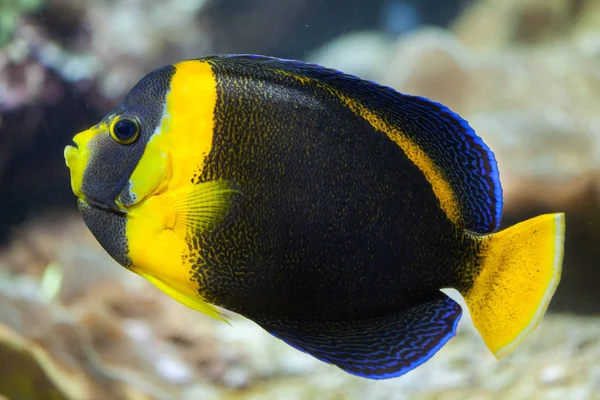
The Scribbled angelfish is considered to be a reef safe angelfish species. They grow to be about 10 inches long when fully grown and require a tank volume of at least 180 gallons.
This angelfish species is semi-aggressive and may harass smaller tank mates. They are found in the Indian and Pacific Oceans near Indonesia and the Philippines.
The Scribbled angelfish requires a diet that includes meaty items such as mysis shrimp, brine shrimp, and squid.
13. Regal Angelfish

The Regal Angelfish is a beautiful, peaceful fish that may reach up to 10 inches long and require 180 gallons of swimming room.
They are native to the Indo-Pacific, and their diet consists of small invertebrates. These angelfish make a great addition to any saltwater aquarium.
Regal angelfish are characterized by their beautiful blue and yellow coloration. They have a long, slender body with a rounded tailfin. The females are usually larger than the males.

